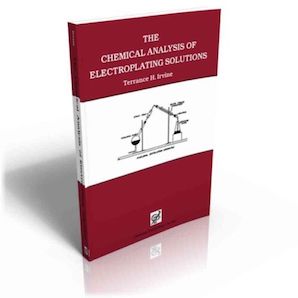
Curated with aloha by
Ted Mooney, P.E. RET

The authoritative public forum
for Metal Finishing 1989-2025

-----
Analyzing acid tin baths -- bright and matte
this text gets replaced with bannerText

[editor appended this entry to this thread which already addresses it in lieu of spawning a duplicative thread]
Q. I'm asking for analytical method for tin analysis in acid tin electroplating?
- Cairo Egypt
January 9, 2024
⇩ Related postings, oldest first ⇩
Q. I am from turkey. I am chemist. I work about plating which nickel, copper, tin, silver, brass, antique. I need some technical information about plating, especially tin baths. If you give technical information about tin baths I will very happy. Also when I analyzed tin baths, metallic tin and sulfuric as it values become wrong. Also I need tin bath analysis. I have some questions about it.
Thanks.. look forward to your answers...
Sincerely...
Efe Galvano - Turkey
2002
sometimes on
AbeBooks or Amazon
(affil links)

free pdf is currently available from academia.edu
A. The Metal Finishing Guidebook will be a good start for your inquiries.

Sara Michaeli
Tel-Aviv-Yafo, Israel
Q. Hello,
I had asked a question about tin baths. But I think you didn't understand me clearly. I want to know how I can analyze tin bath (analysis prospectus). What's optimum values for metallic tin and sulfuric acid. I look forward to your answers.
Sincerely,
Efe Galvano - Turkey
A. Metal Finishing Guidebook has baths, testing Procedures and even some troubleshooting. Be smart and check out the book.
Chris Snyderplater - Charlotte, North Carolina
A. Hi Alaattin,
Readers are happy to answer highly specific questions in this forum, but asking how to analyze a tin baths without specifying stannate, MSA, sulphate or fluoborate, or whether you have access to AA, ICP, titrametric, gravimetric, Hull Cell ⇦ ?
, or other instrumentation, and asking for optimum values without specifying barrel vs. rack vs. wire plating, or acid vs. alkaline, people must refer you to books because it would take many paragraphs to handle the ifs-ands-&-buts. After thumbing through the book, please pose a more detailed question. Thanks!
Luck & Regards,

Ted Mooney, P.E. RET
Striving to live Aloha
finishing.com - Pine Beach, New Jersey
Bright tin vs. matte tin analysis
Q. I work in a barrel plating shop and have made up a new Matte Tin bath. Problem is that the old bath was never titrated, and I have no info on how to do this.
My chemical rep has faxed me a titration sheet, but I do not have the reagents they suggest.
The tank is 82.5 gallons. The two obvious make-ups are stannous sulfate and sulfuric acid. I titrate my bright tin for these same two components. Those tanks are 380 g. and 180 g. of which I have a calculation sheet to determine the concentration of the two above listed chemicals. Shouldn't I be able to check the Matte Tin in a similar way? How would I convert this? My plating background is very strong. But my lab experience is relatively new. The new bath is working great, but I want to make proper adds, not just shoot from the hip.
As a side note, I was very surprised to learn that the previous Matte Tin bath was kept alive and kicking for four years without titration.
Plating Shop - Lawrence, Massachusetts, U.S.A.
2005
A. Yes you can titrate the matte tin bath using the same procedures and chemicals since you are checking the same type of electrolyte with different additives.
Gene Packmanprocess supplier - Great Neck, New York
Turbidity vs. Sn +4 contamination?
Hi All,
Hi I'm Cherrie Mae San Pablo from Philippines. I am a Laboratory analyst in a semiconductor manufaturing company.
I have encountered a situation wherein a clear plating solution has much higher Sn+4 content compared to a turbid solution. Does really turbidity of a solution contributes to the existence of Sn+4 contamination? What are the other probable reasons why solutions turn turbid? Does it also indicate that the turbid the solution the greater the chances of whisker formation?
Hope to get clarifications from you. Thanks.

Cherrie Mae San Pablo
Plating shop employee - Philippines
2007
Hi Cherrie,
A turbid tin plating solution should have higher stannic content than the clear solution. You probably need to do re-analysis to double check the results. There is actually no direct relationship between stannic and whisker or dendrite growth. One concern of tin plate solution with too much stannic is the adsorption of stannic in the plated tin layer which may result to discoloration during storage or heat application. You can minimize formation of stannic but you cannot totally eliminate. To reduce turbidity of the plating solution, you need to increase filtration efficiency. Good luck.
- Philippines
2007
Your Sn2+ has been oxidized to Sn4+. Look for sources of air getting introduced on your bath and eliminate it. It happened to me once when replacing filters. Air filled the empty portion of cartridge and eventually gets into the bath. The bath bubbled for a few seconds and the solution turned turbid.
Franz CantillanoPlating - Cavite, Philippines
2007
[editor appended this entry to this thread which already addresses it in lieu of spawning a duplicative thread]
Q. How to do analysis for tin plating solution to find out tin metal, tin sulphate, sulfuric acid?
student - Ahmednagar, India
November 5, 2012
by Terrance H Irvine

on eBay or
AbeBooks
or Amazon
(affil links)
A. Hi Prajkta
One titrametric analysis for the tin metal can be found on topic 53762.
Langford & Parker's "Analysis of Electroplating and Related Solutions" [on
AbeBooks or
eBay or
Amazon affil links]
and Irvine's "The Chemical Analysis of Electroplating Solutions" ⇨
are good sources for specific analysis procedures for plating solutions.
Luck & Regards,

Ted Mooney, P.E.
Striving to live Aloha
finishing.com - Pine Beach, New Jersey
Q, A, or Comment on THIS thread -or- Start a NEW Thread